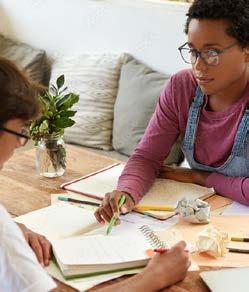
3 minute read
Summer is for Tutoring: How Can We Help Low Achieving Students Catch Up?
by Elaine Clanton Harpine, Ph. D
A very bright third-grade child walked into my reading clinic one day in total despair. He was unable to read even the easiest first-grade books. He was also totally convinced that he would never be able to learn to read. Less than a year later, he was devouring chapter books. He was very proud of being able to read, and carried a book with him everywhere he went.

What made the difference? Teaching method.
A 15-year-old learned to read before she graduated from high school. She had failed for nine straight years. The school had tried balanced literacy, reading recovery, and even one-on-one systematic phonics tutoring. She was reading at the pre-kindergarten level when she entered my reading clinic. She knew consonant sounds, but she did not know any of the vowel sounds when she started with me. With vowel clustering, she learned to read in 3 ½ years.

What made the difference? Teaching method.
A 5th grader was reading between the 2nd and 3rd grade level with very low comprehension when he came to me for tutoring. After 21 weeks of onehour, once-a-week tutoring using vowel clustering, he was reading at the 6th grade level with strong comprehension scores.
Each of these students were taught using my one-on-one tutoring method from my newest book: Why Can’t We Teach Children to Read: Oh, but Wait, We Can, A Step-by-Step Plan for Teaching Your Child to Read. This book has everything needed to teach any struggling student to read. It’s written for parents, teachers, and tutors. Works for all ages, even adults. If you have questions about the book or how to teach from the book, contact me.

Summer is a great time for tutoring students who are struggling in reading. I use vowel clustering with all of my students.
Vowel clustering teaches struggling students to both see and hear different vowel sounds. The vowel center organizes words by sound. The vowel center also demonstrates visually how the same letters can combine but represent different sounds.
An example from the book illustrates how we can help struggling students by using a vowel board. Students can match words with vowel sounds. The EA vowel cluster makes a good example for how to use the vowel board. This is a preview from p. 84:
Copyright © Elaine Clanton Harpine

“… every ea sound is different, and only three of the sounds are actually e sounds: eat, breakfast, hear The ea combination uses the long vowel sound for ē in the word eat, the short vowel sound for ĕ in the word breakfast, and the ear (îr) sound in the word hear The words break, heart, and tear [tear paper] all use letter a sounds (break ā, heart är/as in car, tear âr/air sound), and the word earth uses the ûr sound.” I pointed to each section on the ea vowel strip as I explained these different sounds. Then, we practiced the 4 steps with each word.”
If you have questions about using a vowel board, contact me. I am always happy to help. Contact me at clantonharpine@hotmail.com
Have a great summer.
Dr. Elaine Clanton Harpine, Ph. D.











